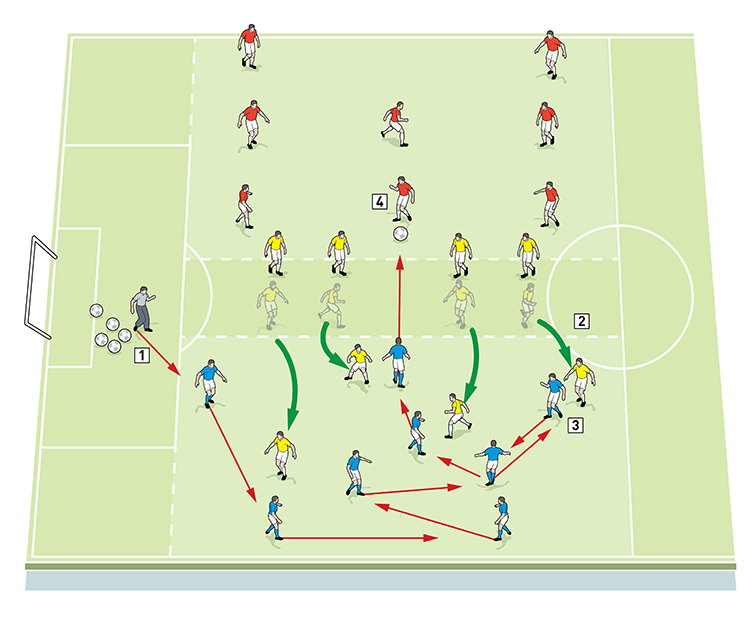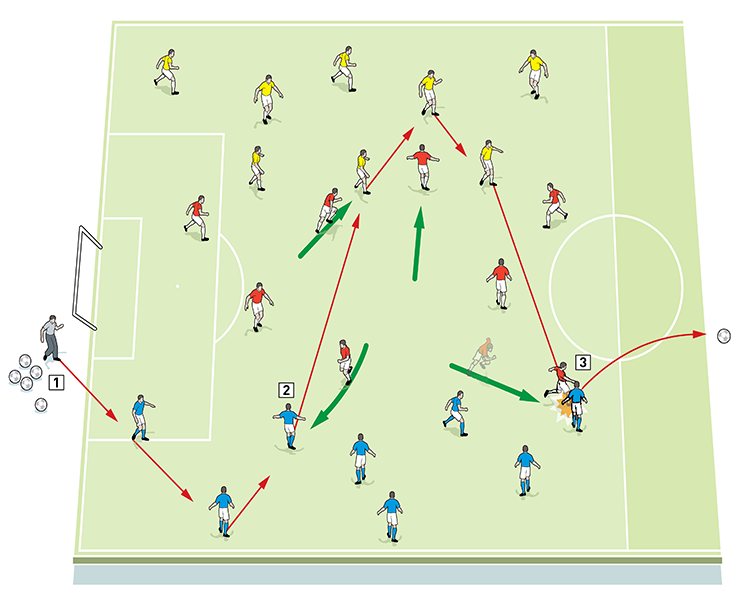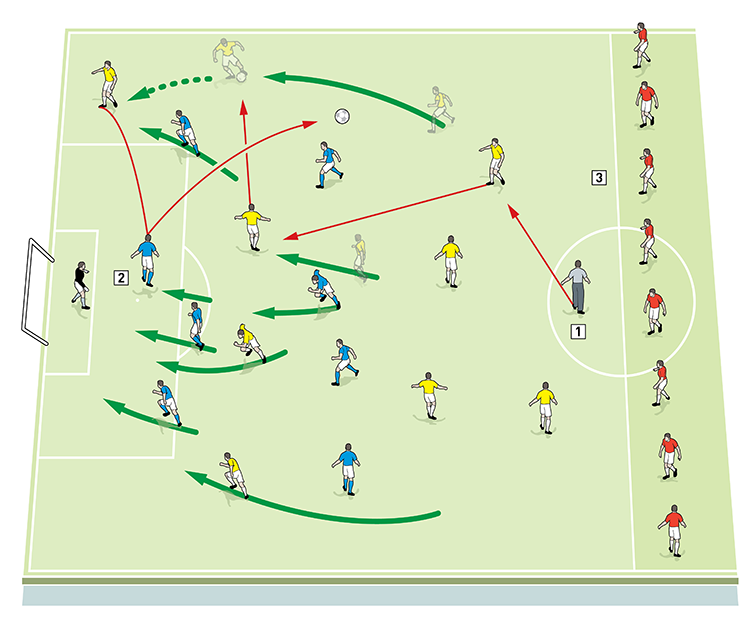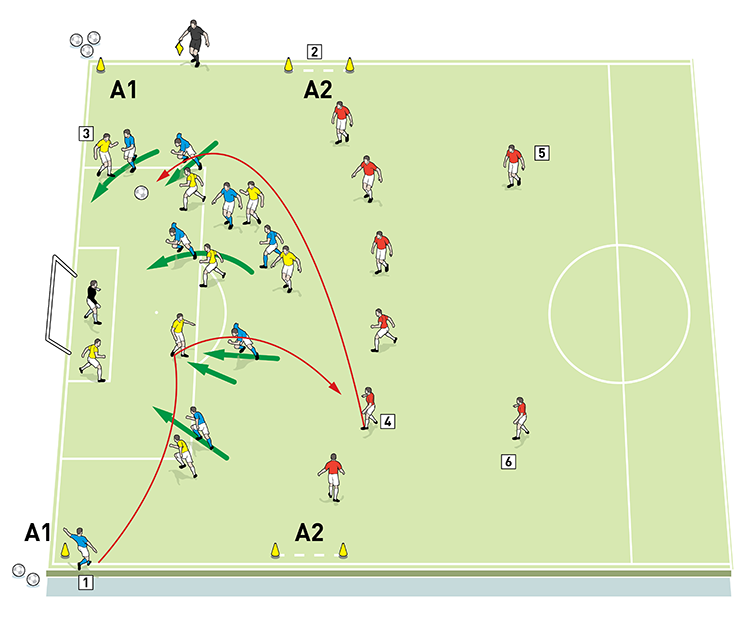




OUR BEST EVER OFFER - SAVE £100/$100
JOIN THE WORLD'S LEADING PROFESSIONAL DEVELOPMENT PROGRAMME
- 12 months membership of Elite Soccer
- Print copy of Elite Player & Coach Development
- Print copy of The Training Ground
Solid defending
Use this session to create a positive mindset to defending – it makes teams hard to beat and teaches players not to concede cheap goals.
| Area | Half a pitch |
| Equipment | Balls, bibs, cones, 2 full size goals |
| No. of Players | 24 players + 2 goalkeepers |
| Session Time | Each practice: 20mins |
This is a session that I use with the first team squad. I use it to create a positive mindset to defending – I find it makes teams hard to beat and teaches players not to concede cheap goals.
It makes for an enjoyable and competitive session and it is played at match intensity because the three teams are competing to win in each of the five practices.
The players work hard physically and also work hard on the tactical and technical aspects of the session.
I have used 24 players here, but I have also used the same session with 18 or 21 players.
What do I get the players to do?
Practice 1
We set up on half a pitch, with the playing area marked out between the 18-yard line and the halfway line, and with a centre zone down the middle of the area, as shown [1].
1

2. Four yellows from the centre can enter the end zone to press the ball. They score a point if they win it and clear it out of the area
3. The blues must make eight passes before transferring the ball to the team at the other end. They score a point for making eight passes
4. On receiving the ball, the reds become the new possession team and must string eight passes together under pressure
We’re using 24 players split into three teams of eight, with a team at each end and one team in the centre zone.
One of the end teams starts with the ball and four players from the centre can go into that end zone to press.
The possession team make eight passes before trying to transfer the ball to the opposite end zone. They score one point for making eight passes.
The pressers try to win possession and score one point if they get hold of the ball and clear it out of the area.
Play for 20 minutes, rotating teams every two minutes.
How do I progress the session?
Practice 2
To progress Practice 1, extend the playing area so it now covers half the pitch and remove the centre zone. The two end teams must now work together to keep possession under pressure from the pressing team, making it a 16v8 game. If the pressers win the ball, they must clear it out of the area, as shown [2].
2

2. In this progression, the centre zone has been removed and the two end teams now work together to keep possession
3. Here the reds are the pressers. If they win the ball, they clear it to score. Rotate teams and see which team of pressers score the most
Play for 20 minutes and rotate teams every two minutes. Keep score so you know which team wins the ball back the most when acting as pressers.
Make sure the pressers defend as a team and encourage them to use good communication. They should be displaying a positive and committed attitude to defending.
What do I get the players to do next?
Practice 3
We set up on half a pitch, with a goal and a goalkeeper at one end, as shown [3]. We’re using 24 outfield players, split into three teams of eight. One team defends and the other two take turns to attack – allow each team three attacks before rotating teams and make sure everyone has a turn to defend.
3

2. The defending team try not to concede from open play. Here they clear the ball
Teams must try not to concede from open play. The offside rule applies so make sure players play to the whistle. This will make it very match realistic.
What are the key things to look out for?
In Practice 3 we want to see defenders staying on their feet and delaying the attacking team. We also want to see good communication used by the defenders, so units can work together to break up attacks.
Defenders should try to make attacking play predictable by forcing opponents to make backwards or square passes. Players should also be prepared to make recovery runs to get back behind the ball when defending.
We want the defenders to display a positive attitude and to see they are committed to the idea that they aren’t going to concede any goals.
What do I get the players to do next?
Practice 4
Using the same set-up as before, this activity is used to practise defending against corners and free-kicks. We’re using three teams of eight plus a keeper, with one team defending, one team attacking the goal, and the third team waiting as deeper attackers who can recycle any clearances.
Teams each take turns to defend against three corners from the left and three corners from the right, taken from positions A1, as shown [4]. They then defend three free-kicks from the left and another three from the right, taken from positions A2.
4

2. Repeat the process for free-kicks from positions A2, with three from the left and three from the right
3. Defenders should keep tight and mark the blue attackers man for man
4. Here the yellows have cleared the ball but the reds keep it in play and launch a second phase attack. The reds have two touches between them
5. Two reds sit further back to keep any deeper clearance in play and they also have two touches between them to launch the ball into the area
6. Rotate the teams after six corners and six free-kicks
The deep attackers can create second phase defending opportunities by keeping the ball in play and extending the action, but we limit this team to two touches between them to get the ball back into the penalty area. Play for 20 minutes.
The offside rule applies.
What are the key things to look out for?
In Practice 4 we want to see the defenders firmly attacking the ball to clear it to safety, but concentration is vital to avoid the danger of second and third phase attacks.
Defenders must also show they are alert to blocking shots and can react to cover short corners or any dangerous improvisation by the attackers.
As a by-product of this defensive practice, we find attacking teams show good movement, creativity and improvisation in attempting to score.
How would you put this into a game situation?
Practice 5
We set up on half a pitch with a goal and a goalkeeper at each end. We’re using 24 outfield players divided into three teams of eight. Two teams play 8v8 plus goalkeepers in the main area and the third team are positioned around the outside to help the team in possession, as shown [5]. The outside players are limited to two touches.
5

2. The third team starts on the outside and can help the team in possession. But outside players are limited to two touches
We play a round robin competition between the teams and keep a note of the scores. We allow just a few seconds between games for players to organise themselves.
We can progress the practice by making it ‘winner stays on’. This adds fitness to the game and shows how players respond when they have been on the pitch for longer than the opposition and must make decisions based on this added pressure.
Related Files
Editor's Picks
Attacking transitions
Deep runs in the final third
Using the goalkeeper in build-up play
Intensive boxes drill with goals
Penetrating the final third
Creating and finishing
My philosophy
Pressing initiation
Compact team movement
Coaches' Testimonials

Alan Pardew

Arsène Wenger

Brendan Rodgers

Carlos Carvalhal

José Mourinho

Jürgen Klopp

Pep Guardiola

Roy Hodgson

Sir Alex Ferguson

Steven Gerrard
Coaches' Testimonials

Gerald Kearney, Downtown Las Vegas Soccer Club

Paul Butler, Florida, USA

Rick Shields, Springboro, USA

Tony Green, Pierrefonds Titans, Quebec, Canada
Join the world's leading coaches and managers and discover for yourself one of the best kept secrets in coaching. No other training tool on the planet is written or read by the calibre of names you’ll find in Elite Soccer.
In a recent survey 92% of subscribers said Elite Soccer makes them more confident, 89% said it makes them a more effective coach and 91% said it makes them more inspired.
Get Monthly Inspiration
All the latest techniques and approaches
Since 2010 Elite Soccer has given subscribers exclusive insight into the training ground practices of the world’s best coaches. Published in partnership with the League Managers Association we have unparalleled access to the leading lights in the English leagues, as well as a host of international managers.
Elite Soccer exclusively features sessions written by the coaches themselves. There are no observed sessions and no sessions “in the style of”, just first-hand advice delivered direct to you from the coach.








